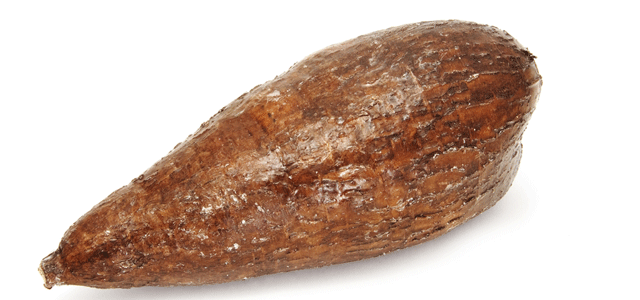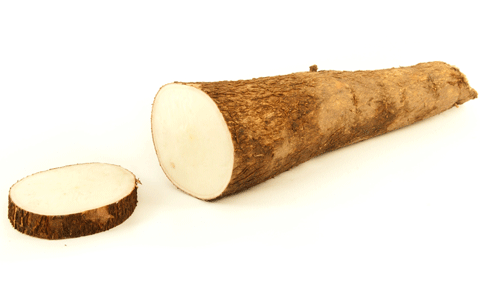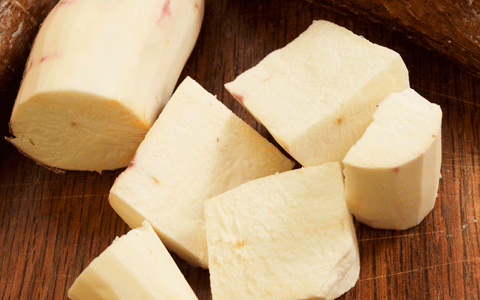Cassava, also known as manioc, yuca, and tapioca, is an elongated tuberous root native to South America, and an excellent source of carbohydrates. Underneath the easily bruised brown skin of this starchy root lies a pale white interior, which can be cooked any number of ways. Cassava turns slightly yellow and translucent when cooked, and this staple of South American and Caribbean cooking can be boiled, fried, steamed, baked, grilled or mashed, and is sometimes even dehydrated to form a powder to make bread or dumplings. Cassava exists in two varieties, sweet and bitter, but given that the bitter variety contains significant amounts of poisonous Prussic acid, it’s the sweet variety that you’ll find in your local supermarket. Choose cassava that is firm to the touch, with no soft spots or obvious bruises.
1. The first step in preparing cassava for cooking is to cut the tapered ends off of the root, and then cut the root into segments, which are four to six inches long.
2. Next, you’ll need to remove the skin. Since vegetable peelers don’t generally work well with the thick skin of the cassava, you’ll need to stand the individual pieces on one cut end and slice the peel away with a sharp blade, rotating the piece as you shear off the skin until only the white flesh remains.
3. Given the meaty density of cassava, further cutting down of the root will be required to ensure even and thorough cooking. Keeping the peeled sections up on one end, cut each piece in half lengthwise, and then cut these halves in half lengthwise a second time. Each four to six-inch section should now be cut into four quarters.
4. These quartered segments should possess an exposed woody core at their inner corners, which will need to be removed and disposed of. To do this, carefully cut the inner corner of each quarter off with a sharp knife and throw it away. Your cassava segments are now ready to be boiled, fried, roasted or sautéed.
Tip: If you’re not using the prepared cassava pieces immediately, they can be preserved in a bowl of water, covered in plastic wrap and placed in the refrigerator for three to four days. Preparing cassava ahead of time is a particularly handy way to take a little of the stress out of putting together an elaborate meal for guests.




![Making Mealtime Matter with La Familia: Easy Sofrito [Video]](https://thelatinkitchen.com/wp-content/uploads/2015/10/sofrito-shutterstock__0-500x383.jpg)
![Easy Latin Smoothies: Goji Berry Smoothie [Video]](https://thelatinkitchen.com/wp-content/uploads/2015/12/goji_berry-shutterstock_-500x383.jpg)
















![Fun and Fast Recipes: Fiesta Cabbage Salad [Video]](https://thelatinkitchen.com/wp-content/uploads/2015/11/fiesta_cabbage_slaw-shutterstock_-500x383.jpg)









